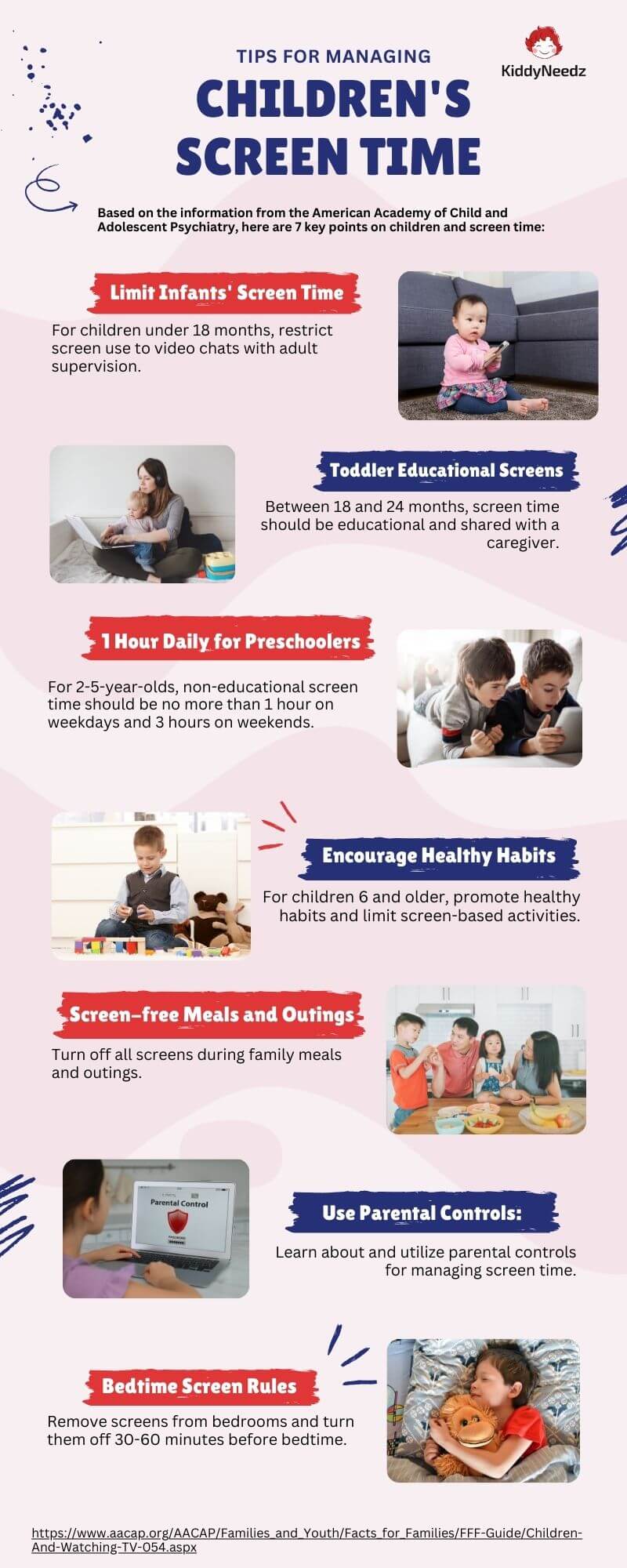As a parent, you might be concerned about the amount of time your child spends staring at a screen. With technology becoming an integral part of our lives, it’s getting harder to control how much screen time our children get.
But is there a limit? How much screen time is too much for your child?
In this article, we’ll understand what screen time is, the impact excessive screen time can have on your child, and the recommended daily screen times for different age groups. We’ll also explore strategies you can use to manage your child’s screen time and the positive aspects of screen time that you might not have considered before.
Read on to find out if it’s possible to have too little screen time and how you can help your child develop healthy habits when it comes to technology.
- What does screen time mean?
- The Impact of Excessive Screen Time on Children
- How much screen time is too much?
- Strategies to Manage Your Child's Screen Time
- The positive Aspects of Screen Time
- Is it Possible to Have Too Little Screen Time?
- Frequently Asked Questions
- How do you manage the screen time of your kids?
What does screen time mean?
Screen time refers to how much time your child spends per day using electronic devices with screens. This time may be spent on activities such as watching TV, playing video games, using apps, and browsing the internet.
Television, tablets, computers, smartphones, video games, social media apps, and online videos are the most common sources of screen time for kids. These electronic devices and platforms are prevalent in the lives of children and contribute significantly to their screen-time activities.
Total screen time includes any interaction or engagement with digital screens, and its definition can evolve with the introduction of new digital technologies.
As parents, we must manage and regulate the total screen time our kids spend across these sources. This is essential for promoting a balanced and healthy lifestyle in them.

The Impact of Excessive Screen Time on Children
Excessive screen time can have severe physical, mental, and social effects on your child, many of which can be detrimental to their well-being. Let’s understand these consequences in more detail.
A. Physical Effects
Prolonged screen time can result in various physical effects, such as:
- Eye Strain and Discomfort: Prolonged screen use can lead to eye strain, discomfort, and even digital eye strain syndrome, also known as “computer vision syndrome.” This condition is characterized by symptoms such as dry eyes, blurred vision, and headaches.
- Headaches: Excessive screen time is often linked to an increased frequency of headaches, particularly tension headaches and migraines. The extended periods of focusing on screens can contribute to these discomforts.
- Increased Body Weight: A sedentary lifestyle resulting from excessive screen time can lead to weight gain and obesity, especially in children and adolescents. Reduced physical activity and an increased likelihood of snacking while watching screens can contribute to this issue.
- Sleep Disruptions: The blue light emitted by screens can interfere with the body’s production of melatonin, a hormone responsible for regulating sleep. This disruption can lead to difficulties falling asleep, staying asleep, and experiencing restorative sleep, ultimately affecting overall health.
- Muscle and Joint Problems: Poor posture while using electronic devices can result in muscle and joint problems. These issues may manifest as neck pain, back pain, or repetitive strain injuries in the wrists or fingers, commonly referred to as “texting thumb.”
- Physical Health Complications: Prolonged screen time, often associated with a sedentary lifestyle, can contribute to various physical health complications such as cardiovascular diseases, diabetes, and musculoskeletal disorders. These conditions can have long-term detrimental effects on overall health and quality of life.
- Reduced Outdoor Activity: Excessive screen time tends to replace outdoor physical activities, reducing exposure to fresh air and sunlight. This lack of outdoor time can lead to vitamin D deficiency, weakened immunity, and a reduced opportunity for physical exercise and social interactions.
B. Psychological Effects
Excessive screen time its overuse can also have significant psychological repercussions, particularly on children, adolescents, and even adults.
- Depression and Anxiety: One of the most prevalent psychological effects of excessive screen time is an increased risk of depression and anxiety. Constant exposure to screens, especially on social media platforms, can lead to feelings of inadequacy, low self-esteem, and social isolation. The incessant comparison with idealized images and lifestyles portrayed online can contribute to a sense of unhappiness and anxiety.
- Screen Time Addiction: Young people, in particular, are susceptible to screen time addiction. The instant gratification provided by video games, social media notifications, and online entertainment can lead to compulsive and unhealthy usage patterns. This addiction can negatively impact their academic performance, sleep patterns, and overall well-being.
- Impaired Cognitive Development: Excessive screen time can hinder cognitive development, especially in children. It can disrupt their ability to concentrate, solve problems, and engage in critical thinking. Frequent distractions from screens can impede the development of important life skills.
- Reduced Physical Activity: Spending too much time on screens often translates to reduced physical activity. This sedentary lifestyle can contribute to health issues such as obesity and related conditions, further impacting mental health by diminishing self-esteem and body image.
- Impaired Sleep Patterns: The blue light emitted by screens can disrupt sleep patterns, making it difficult for individuals to fall asleep and stay asleep. Poor sleep quality and inadequate sleep duration can exacerbate feelings of irritability, stress, and mood disorders.

C. Social Implications
Not only can excessive screen time have negative physical and psychological implications on your child, but it can cause social impairment too. Here are some of the key social consequences associated with excessive screen time:
- Social Isolation: Excessive screen time can lead to social isolation, as individuals spend more time engaging with screens than with people in face-to-face interactions. This can result in reduced opportunities for meaningful connections and the development of social skills.
- Decreased Quality of Relationships: In cases where screens dominate social interactions, the quality of personal relationships can suffer. Constant screen distractions during family meals or gatherings can hinder communication and bonding among family members.
- Cyberbullying: The prevalence of social media and online communication platforms has given rise to cyberbullying, which can have devastating effects on the mental and emotional well-being of young people. Excessive screen time can expose individuals to these negative online experiences.
- Social Comparison: Social media platforms often showcase curated and idealized versions of people’s lives, leading to a phenomenon known as “social comparison.” Excessive screen time can contribute to feelings of inadequacy and low self-esteem when individuals constantly compare their own lives to the seemingly perfect lives of others online.
- Screen Addiction: Excessive screen time can lead to screen addiction, where individuals become compulsively engaged with their devices and prioritize screen-related activities over real-world interactions. This addiction can disrupt social relationships and responsibilities.
- Decline in In-Person Communication Skills: Extended screen use can diminish in-person communication skills, particularly among children and adolescents. Reduced face-to-face interactions may lead to difficulties in reading social cues and developing effective interpersonal skills.
- Impact on Family Dynamics: Excessive screen time within families can strain relationships and create conflicts. Parents may struggle to set and enforce screen time rules, leading to disagreements and disruptions in family life.
- Decline in Outdoor Activities: Excessive screen time often replaces outdoor activities and physical play among children. This can lead to a lack of opportunities for socializing with peers in a natural setting and contribute to a sedentary lifestyle.

How much screen time is too much?
The American Academy of Pediatrics (AAP) offers age-specific recommendations for screen time, crucial for promoting healthy media use in children and teenagers.
Pediatricians play a key role in educating parents about these guidelines and supporting their overall well-being. Implementing age-appropriate limits and promoting quality screen time can contribute to a balanced and healthy digital lifestyle. Understanding and adhering to these guidelines is essential for ensuring the healthy development of children and young people.
Navigating the complex world of screen time for children can be challenging for parents and caregivers. Understanding the recommendations of the American Academy of Pediatrics (AAP) can provide a helpful framework.
These guidelines are designed to balance the benefits of media with the potential impacts on a child’s development.
- Until 18 Months: For the youngest children, those until 18 months of age, the AAP advises limiting screen use primarily to video chatting. This should be done in the presence of an adult, fostering interaction and guidance.
- 18 to 24 Months: At this tender age, the focus shifts slightly. While still limiting screen time, the AAP recommends that it should be geared towards watching educational programming. Importantly, this activity should be shared with a caregiver, enhancing the learning experience through interaction and discussion.
- 2 to 5 Years: As children grow and their understanding deepens, screen time guidelines become more defined. The AAP suggests limiting non-educational screen time to about 1 hour on weekdays and 3 hours on weekend days. This recommendation underscores the importance of maintaining a balance between screen time and other developmental activities.
- 6 Years and Older: For children over 6, the AAP doesn’t specify exact time limits. Instead, the focus is on encouraging healthy habits and limiting activities that include screens. The emphasis here is on ensuring that screen time does not replace time needed for sleep, physical activity, and other behaviors essential to health.
These guidelines are a part of a broader approach that emphasizes the quality of screen time rather than just the quantity. It’s about making informed choices that support a child’s overall development, ensuring that their engagement with screens is balanced, educational, and appropriate for their age.

Strategies to Manage Your Child’s Screen Time
I do agree that managing your child’s screen time can be a significant challenge. However, with the right strategies, you can ensure that your child’s digital experiences are healthy, balanced, and beneficial for their development.
- Create a Family Media Plan: One of the most effective strategies is to develop a Family Media Plan. This plan, recommended by the American Academy of Pediatrics, involves setting clear guidelines and expectations about media use that cater to the specific needs of each child and the family as a whole. This plan can include designated screen-free zones, times for screen use, and types of permissible content.
- Engage in Co-viewing and Discussion: When your children do use screens, make it an interactive and shared experience. Co-viewing and discussing content with your children can turn screen time into an opportunity for learning and bonding. This approach also allows you to understand their interests and guide them towards appropriate and educational content.
- Promote Active Use Over Passive Consumption: Encourage your children to use screens for creative, educational, and interactive activities rather than passive consumption like scrolling through social media or watching videos. Activities like educational games, programming, or creating digital art can be more beneficial.
- Set Consistent Limits: Consistency is key in managing screen time. Set clear and consistent limits on the amount of time your child can spend on screens daily, and stick to these limits to help your child develop a healthy relationship with technology.
- Lead by Example: Children often mimic the behavior of their parents. Show your children a balanced approach to technology by being mindful of your own screen use. Limit your screen time, especially during family interactions, to set a positive example.
- Encourage Other Activities: To prevent screen time from dominating, encourage your child to engage in other indoor activities, outdoor play, reading, hobbies, and sports. This not only limits their screen time but also promotes well-rounded development.
- Use Parental Controls and Safe Search Options: Utilize parental controls to manage the content your child can access. Safe search settings on search engines and age-appropriate filters on streaming services can protect your child from inappropriate content.
- Stay Informed and Involved: Keep yourself updated about the latest trends in digital media and the kinds of media your child is consuming. This awareness will help you make informed decisions about your child’s screen use.
By implementing these strategies, you can help ensure that your child’s interaction with screens is balanced, enriching, and in line with their developmental needs. Remember, the goal is not to eliminate screen time but to manage it effectively for the benefit of your child’s overall growth and well-being.

The positive Aspects of Screen Time
Recognizing the positive benefits of age-appropriate media content is essential for promoting cognitive development in children.
Digital media offers a wealth of educational possibilities, including interactive apps and digital resources that can enhance learning and exploration. Emphasizing age-appropriate content and promoting a healthy relationship with screens is crucial to maximizing the educational opportunities that screen time provides.
Positive social interactions through screen time can enhance communication skills and facilitate virtual connections with peers. Additionally, recreational screen time plays a crucial role in fostering healthy relationships and familial bonding.
By recognizing the value of digital media in fostering learning and exploration, we can develop responsible viewing habits in our kids. This will have a positive impact on their development, social interactions, and education in the long run.
Is it Possible to Have Too Little Screen Time?
Is there such a thing as too little screen time?
While it’s important to limit excessive screen use, having too little screen time can hinder digital literacy and educational opportunities. Age-appropriate media content plays a role in learning, and a healthy relationship with digital media can foster positive social interactions.

Frequently Asked Questions
Is 7 hours of screen time too much?
7 hours of screen time for a child is generally considered excessive. According to the American Academy of Pediatrics, children aged 2-5 should have no more than one hour of screen time per day, while children aged 6 and older should have consistent limits. Excessive screen time can negatively impact physical health, mental health, and social development. Parents should monitor their child’s screen time and encourage other activities.
How much screen time is OK for a day?
The American Academy of Pediatrics recommends limiting screen time to one hour per day for children aged 2 to 5. For older children, parents should establish consistent limits and balance screen time with physical activity and socialization. Monitoring and adjusting screen time as necessary is essential.
Is 2 hours of screen time ok?
The American Academy of Pediatrics recommends limiting screen time to 1 hour per day for children ages 2 to 5, and 2 hours for children ages 6 and up. However, the quality of the content is also important. Make sure your child engages in physical activity and non-screen activities throughout the day.
What is excessive screen time?
Excessive screen time varies based on age and individual circumstances. The American Academy of Pediatrics recommends limiting screen time to one hour per day for children aged 2 to 5 years, and two hours per day for children aged 6 and older. When screen time interferes with daily activities like sleep and physical activity, it is considered excessive.
What are some alternative activities that can be beneficial for children instead of screen time?
Encouraging physical activity, such as playing outside or participating in sports, helps children stay active and promotes healthy growth. Creative activities like drawing, painting, and writing foster imagination and cognitive skills. Reading books improves literacy and language abilities. Spending quality time with family and friends, playing board games or engaging in meaningful conversations, enhances social skills.
Are there any age-specific recommendations for screen time limits?
Yes, there are age-specific recommendations for screen time limits. The American Academy of Pediatrics advises no screen time for children under 18 months old and limited screen time for children between 2-5 years old. For children ages 6 and up, it is recommended to have consistent limits on screen time and prioritize other activities. Individual needs and interests should also be considered when setting screen time limits.
How do you manage the screen time of your kids?
The effects of excessive screen time encompass physical discomfort, mental health challenges, and social consequences. Hence, finding the right balance between digital engagement and real-world interactions is essential.
According to you, how much screen time is too much for your kids? How do you manage their screen time? What strategies have you found effective in striking a balance between the benefits and potential drawbacks of digital technology in your family’s life? Share your experiences and insights in the comments below.
Let us all share our strategies and collectively work towards promoting healthier screen time habits and fostering a balanced and fulfilling lifestyle for ourselves and our children in the digital age.






Leave a Reply